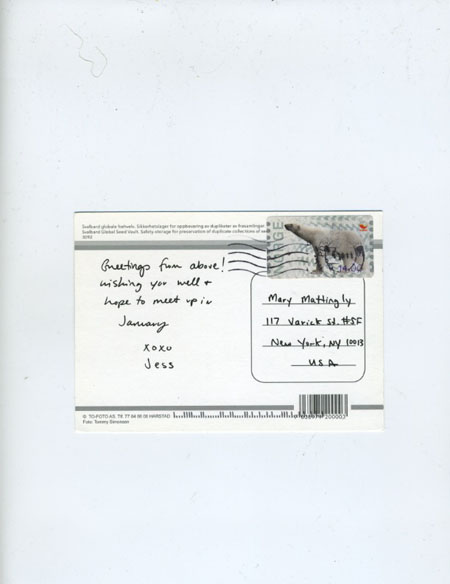![]() body | color | collections | commodity | cube | document | fabric | fetish | gender | glass | home | identity | living | machine | metal | minimal | mobility | narrative | olfactory | organic |
body | color | collections | commodity | cube | document | fabric | fetish | gender | glass | home | identity | living | machine | metal | minimal | mobility | narrative | olfactory | organic |
![]() pain | paper | plastic | plugs | power | protective | rectangular | ritual | round | sound | souvenir | spiritual | style | text-based | time | tool | touch | uniform | value | visual | warm | wood
pain | paper | plastic | plugs | power | protective | rectangular | ritual | round | sound | souvenir | spiritual | style | text-based | time | tool | touch | uniform | value | visual | warm | wood
| Postcard with Polar Bear Stamp | |||
Narrative: A postcard from Jessica Hann. The points of most ballpoint pens are made out of brass, which is an alloy of copper and zinc. Oleic acid, castor oil, or a sulfonamide plasticizer are also used. The markers bodies, caps, and plugs are formed from plastic resin. The marker reservoirs are formed from polyester. Powder and water are used to form the felt writing tip. In addition, markers require ink, and the pigments and synthetic substances used to make it. To make the body of the marker, plastic resin is injection-molded into a marker body. Injection molding involves heating plastic resin, into a molten state and forcing (injecting) it into a mold of the desired shape, then allowing it to cool and harden. Marker caps and plugs are formed in the same manner as the barrel. The nib, or tip, of the marker is made from powder mixed with water, molded, and baked into its pointed or flat form. Using one machine for all the following functions, an assembler then places a polyester cylinder inside the marker barrel to form a reservoir for the ink, fills the reservoir with ink, and inserts the nib at the bottom and the cap at the top. The markers are then placed into color assortment and packaged for retail marketing. Sticker postage stamps, ink-based stamps, and airmail stickers still need to be accounted for here. Text was typed on a typewriter and pencil drawn. Graphite combined with clay and wax or other chemicals make up the center of the pencil. The wood used to manufacture pencils must be able to withstand repeated sharpening and cut easily without splintering. Most pencils are made from California cedar. Some pencils have erasers, which are held on with a ferrule, a metal case that is either glued or held on with metal prongs. The erasers themselves consist of pumice and rubber. Layered paper is produced by putting a number of sheets of paper in a stack and gluing them together. Using a photographic process a negative of the image is exposed to a flat plate and coated with a light sensitive material. The plate is developed, and the image area is coated with an oily material that will attract ink but repel water. The non-image area is coated. One plate per color is created. The plate is passed under a roller on the printing press, which coats it with water. The image area on the plate, previously treated with the oily material, repels the water and remains uncoated. An ink roller is next passed over the plate. A rubber roller is then passed over the printing plate and the ink from the plate is transferred to it. The card paper is passed under the rubber roller and the ink is transferred to it. This is done in color order. The ink dries before it enters the next roller assembly. This process of wetting, inking, and printing is continuous throughout the card manufacturing run. After both sides of the pasteboards are printed, they are transported to a card cutting station. Precision-cutting machines cut the cards out from the printed sheets. |
 |
||
![]()
